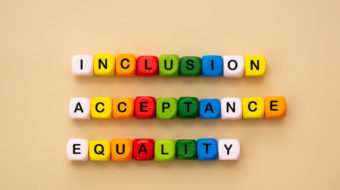Guide to authentic advertising for Gen Z, the queerest generation ever
Is Generation Z the queerest generation ever? Possibly.
7.1% of US adults self-identify as part of the LGBTQ community and Gen Z seems to be the main driver of that growth with 21% identifying as lesbian, gay, bisexual, transgender, or similar. That means that 1 in every 5 adult members of Generation Z self-identify as LGBTQ.
Marketers and advertisers need to take advantage of this opportunity to connect with a larger LGBTQ audience by focusing on authentic advertising.
An open-minded generation
The generational group with the largest proportion of LGBTQ people is Generation Z. They’ve grown up during some of the most pivotal moments for the LGBTQ community including the Supreme Court’s recognition of same-sex marriage.
Not only are Gen Z a majority of the LGBTQ community, but they are also more likely to have friends and family members in the community. So it’s no surprise they’re deeply concerned about the outlook for LGBTQ rights. With the overturn of Roe vs. Wade and 9 states banning transgender athletes from playing on sports teams, the future is certainly discouraging.
The majority of generation Z also grew up fully immersed in the world of social media. Whether it be Twitter, TikTok, Instagram, Facebook, or Linkedin, they’ve always had quick access to information—and vast opportunities to share their own experiences and platform. They’re a unique generation who are unafraid to voice their mind and opinions.
Gen Zers have some key differentiators that set them apart from other generations:
- They don’t remember what life was like before the internet and smartphones and are a digital-first group.
- They are on track to be the most well-educated generation to date.
- They are more racially and ethnically diverse than previous generations.
Connecting with Gen Z through advertising
In 2022, Business Insider estimated Gen Z spending power at over $360 billion in disposable income, more than double what was estimated three years ago. So they have the money to spend, but they’re selective about who they purchase from.
Generation Z consumers want to feel connected to the brands they purchase from. They are deeply interested in the mission and values of an organization and want a greater understanding of how they operate. Things like giving back to the community, transparency, and sustainability are really important to this generation, so marketers may need to adjust their strategies.
When advertising to Gen Z consumers, marketers should focus on a few different areas:
- Authenticity: Authenticity over perfection, always. It’s been shown time and time again that Gen-Z consumers value authenticity when they evaluate products and services. Companies need to prioritize transparency to better connect with Gen Z consumers.
- Storytelling: Everyone has a story to tell and Gen Z wants to hear it. Every day, Gen Zers are bombarded with advertisements from brands and it can be difficult to compete for their attention. Storytelling is a unique way to personalize an ad campaign and evoke empathy and understanding from the reader, making it more like for them to purchase from you.
- Influencer marketing: In 2022, influencer marketing spending increased from 3.69 billion to 4.14 billion in the US alone. With rise of social media and social commerce, those numbers are only expected to increase. It’s not for every brand, but it could be an avenue worth exploring.
- Print advertising: Yes, Gen Z is a digital-first group but they like to consume content in all forms and print media is becoming increasingly popular with this generation.
Using print media to build authentic relationships
Gen Z likes to consume content in a variety of ways, so limiting advertising to digital-only reduces the potential impact of your campaign. There are several reasons why Gen Z connects with print media:
- Tactile experience: Gen Z responds strongly to tactile experiences. MNI Targeted Media conducted a media consumption survey and found that 83% of Gen Z turn to newspapers for trusted information and content, and 34% turn to magazines. This generation is embracing physical products and actively choosing them over digital media.
- More authentic: Print media is known for highly personalized, deeply authentic content. Younger generations have been tricked into inauthentic and misleading information through digital ads for years, so they are experts at spotting them and have high expectations. Print has the reputation of being held to a higher standard, and Gen Z understands that.
- Promotes better focus: How many times have you been reading an article or were simply scrolling through social media when you get a notification? Gen Z is surrounded by screens all day, every day and are being constantly bombarded with notifications. Print media allows them to take a break from those distractions, which means that your brand gets 100% of their attention.
- Nostalgic-like experience: Print never went out of style, but the Millenial generation certainly didn’t connect with print media like we’d hoped. Generation Z has been known to bring back old trends and tried and true favorites. Take vinyl sales for example. In 2021, vinyl sales saw a 94% increase and the main consumers behind that were Gen Z.








